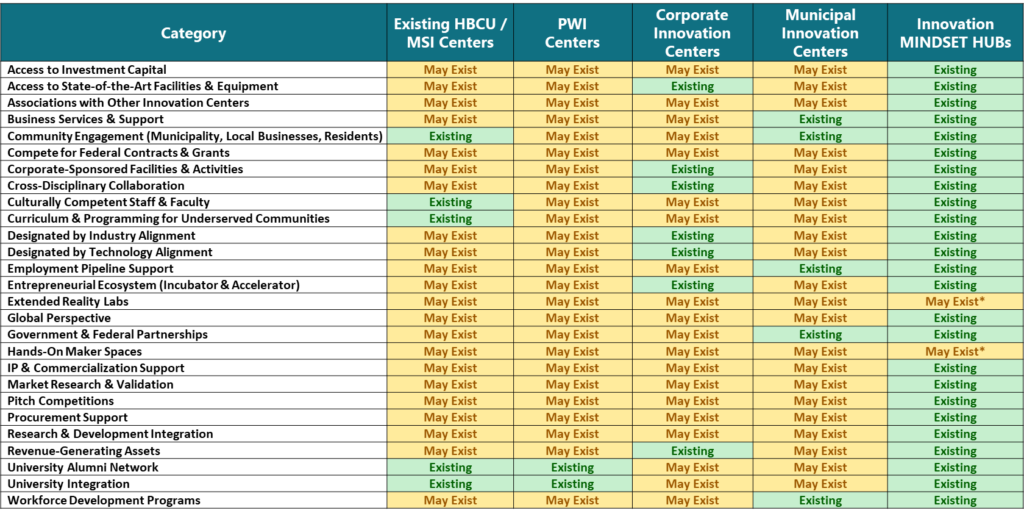
The Competitive Landscape
Revolutionizing Education: Building Innovation HUBs for HBCUs and MSIs
Minority Serving Institutions Defined
It is important to appreciate the university landscape by understanding Minority Serving Institutions as defined by the US Department of Education Office of Postsecondary Education. These colleges and universities of higher education typically enroll predominant populations (i.e., over 50%) of full-time undergraduate students identified as students of color, and they are federally recognized Title IV institutions that are unique in their missions and operations as defined by the primary populations and/or regions they primarily serve. However, some designations require at least 25% or 40% enrollment of a homogeneous minority population to qualify for the designation, and they may also require economic considerations for the students to be met. Please refer to the qualification requirements for each MSI designation under the DoE guidelines to learn more about their unique histories and eligibility requirements. It is critically important to acknowledge that perceived enrollment for a secondary school DOES NOT immediately connote MSI status for an institution – MSI status can only be conferred by the US Department of Education, and in some cases that status must be reconfirmed annually.

PWI vs. MSI Landscape
- Predominantly White Institutions
VS.
- Minority Serving Institutions
- Alaska Native-Serving Institutions and Native Hawaiian-Serving Institutions (16)
- Asian American and Native American Pacific Islander-Serving Institutions (207)
- Historically Black Colleges and Universities (101)
- Hispanic Serving Institutions (539)
- Native American-Serving Non-Tribal Institutions (32)
- Predominantly Black Institutions (65)
- Tribal Colleges or Universities (35)
NOTE: the numbers reflected above are based on official numbers from the DoE site for 2023 (including currently accredited institutions). Additionally, as there is no Federal designation for Predominantly White Institutions, they are generally referred to as those secondary institutions that have not qualified for MSI standing by the DoE with the assumption that at least 50% of students are white; therefore, it is difficult to ascertain the number of PWIs in the US. To understand if an institution is a PWI, please do not assume that designation; first, identify whether the school is currently Federally designated as an MSI, and if not, and the school has an enrolled full-time population over 50%, you may then assume that it is a PWI.
Innovation & Entrepreneurship Center Landscape
With a clear understanding of the differences between MSIs and PWIs, we can now take a deeper look at the competitive landscape of innovation and entrepreneurship centers in the US. Again, the mission of the Innovation MINDSET Alliance is to develop a network of interconnected innovation and entrepreneurship centers at HBCU and MSI campuses to address historical inequalities within communities of color. With that context in mind, let’s examine the typical centers that support innovation and entrepreneurship and their role in addressing our underserved communities.
Existing HBCU / MSI Centers
Several HBCUs and more MSIs have such centers. However, their partners, programs, and success metrics vary widely based on funding.
PWI Centers
Predominantly White Institutions have similar centers given their access to capital and historical relationships with Federal and corporate partners. However, they may not have a focus on underserved communities or supporting innovation from minority founders.
Partner-Led Centers
Corporations, nonprofits, NGOs, and others have created innovation and entrepreneurship centers / programs. They may also have specific mandates to support underserved and underrepresented communities. However, these are often disjointed across industry & technology sectors and not directly unified across HBCUs / MSIs.
Municipal Centers
Federal agencies and municipalities create and operate innovation and entrepreneurship centers / programs as a means of supporting innovation and workforce training. However, they may not connect with HBCUs & MSIs (or even PWIs) or have a minority-driven economic development mandate.

Many of the identified features are listed as “May Exist” given the strategic direction and supported services of the respective centers. “Extended Reality Labs” and “Hands-On Maker Spaces” are listed as “May Exist” for the Innovation MINDSET HUBs because their deployment is an optional feature that can be deployed per each center at an additional cost.
Become More Competitive